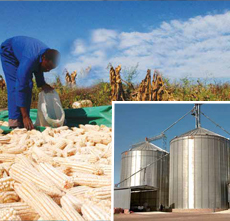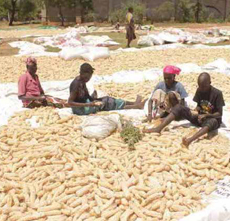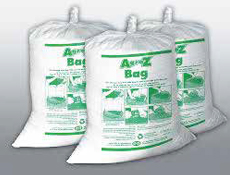Modernizing Grain Storage with Technology: A Post-Harvest Perspective
 Grain storage has been a fundamental aspect of agriculture for millennia, dating back to the early days of human civilization when people realized the importance of preserving surplus crops for lean times. Over the centuries, the methods and technologies used for grain storage have evolved significantly, with the primary goal being to reduce losses due to pests, spoilage, and environmental factors. In recent years, the advent of advanced technology has ushered in a new era in grain storage, enabling farmers to modernize their post-harvest practices and enhance food security.
Grain storage has been a fundamental aspect of agriculture for millennia, dating back to the early days of human civilization when people realized the importance of preserving surplus crops for lean times. Over the centuries, the methods and technologies used for grain storage have evolved significantly, with the primary goal being to reduce losses due to pests, spoilage, and environmental factors. In recent years, the advent of advanced technology has ushered in a new era in grain storage, enabling farmers to modernize their post-harvest practices and enhance food security.
The Need for Modernization
Grain is a staple food source for billions of people around the world, and efficient grain storage is essential for food security. Traditionally, grain storage has been fraught with challenges, including losses due to pests, fungi, and moisture. These losses not only reduce the quantity of available food but also compromise its quality. Additionally, poor storage practices can lead to post-harvest losses, contributing to food scarcity and economic losses for farmers. The world’s population continues to grow, and with it, the demand for grains. To meet this demand, we must optimize every stage of grain production and distribution, starting with post-harvest storage. Modernizing grain storage is not just about improving the bottom line for farmers; it is about ensuring that we can feed a growing global population while minimizing waste.
Smart Silos and Bins
One of the most significant technological advancements in grain storage is the development of smart silos and bins. These storage units are equipped with sensors and monitoring systems that provide real-time data on temperature, humidity, and grain moisture content. This data is crucial for preventing spoilage and infestations, as it allows farmers to take proactive measures.
For example, if the temperature in a grain silo rises above a certain threshold, it may indicate the presence of fungi or insects. With smart technology, farmers can receive immediate alerts and take action to address the issue before it spreads and causes significant damage. This not only reduces losses but also ensures that the stored grain maintains its quality.
Furthermore, smart silos and bins can be connected to central control systems, allowing farmers to remotely monitor and manage multiple storage units. This level of automation and control improves efficiency and reduces the labor required for grain storage management.
 Pest Control through Automation
Pest Control through Automation
Pest control has long been a challenge in grain storage. Insects and rodents can quickly infest grain stores, leading to substantial losses. Traditionally, chemical pesticides were used to combat these pests, but concerns about environmental impact and food safety have prompted a shift toward more sustainable and technologydriven solutions.
One such solution is the use of automated pest control systems. These systems employ various technologies, including sensors, cameras, and automated traps, to detect and manage pest infestations. For instance, sensors can monitor temperature and humidity levels, which can indicate the presence of pests. Automated traps can then be deployed to capture or eliminate the pests, all without the need for chemical interventions.
Additionally, some advanced systems use artificial intelligence (AI) algorithms to predict pest outbreaks based on historical data and current environmental conditions. This proactive approach allows farmers to take preventive measures before pests become a significant problem.
Grain Drying Technology
Moisture content is a critical factor in grain storage. Grains with high moisture content are susceptible to mold growth and spoilage, while those with low moisture content may suffer from brittleness and reduced nutritional value. Therefore, maintaining the optimal moisture level is essential.
Modern grain drying technology has made significant strides in achieving precise control over moisture content. High-efficiency grain dryers utilize advanced techniques such as continuous flow drying, temperature control, and airflow management to remove excess moisture from freshly harvested grain. These dryers can be programmed to achieve specific moisture content levels, ensuring that the grain is stored in optimal conditions.
Furthermore, some grain drying systems are equipped with remote monitoring capabilities, allowing farmers to track the drying process and make adjustments as needed. This not only improves the quality of stored grain but also saves energy and reduces operating costs.
Data Analytics for Decision-Making
In addition to monitoring and automation, data analytics is playing a crucial role in modernizing grain storage. By collecting and analyzing data from various sensors and monitoring systems, farmers can make informed decisions about storage conditions, ventilation, and pest control strategies.
Data analytics can help identify trends and patterns that may not be apparent through manual observation alone. For example, by analyzing historical temperature and humidity data, farmers can determine the optimal storage conditions for different types of grains and adjust their practices accordingly.
Furthermore, data-driven insights can contribute to long-term improvements in grain storage. Farmers can use the knowledge gained from data analysis to refine their storage techniques, reduce losses, and increase the overall efficiency of their operations.
 Sustainable Practices
Sustainable Practices
Modernization in grain storage is not just about efficiency; it’s also about sustainability. Sustainable practices are becoming increasingly important in agriculture, and technology is playing a significant role in achieving this goal. For example, the use of renewable energy sources to power grain storage facilities is reducing the carbon footprint of the agriculture industry. Solar panels and wind turbines can generate clean energy to run the monitoring systems, ventilation, and drying equipment in grain storage facilities.
Additionally, sustainable packaging materials and practices are gaining traction. Farmers are exploring alternatives to traditional plastic bags and containers, opting for biodegradable and recyclable options that reduce environmental impact.
Challenges and Considerations
While technology has brought about significant improvements in grain storage, it also presents challenges and considerations that must be addressed:
1. Cost: The initial investment in modern grain storage technology can be substantial. Small-scale farmers and those in developing countries may face financial barriers to adopting these innovations.
2. Data Security: The collection and storage of sensitive data, such as temperature and humidity readings, raise concerns about data security and privacy. Robust cybersecurity measures are essential to protect this information.
3. Training: Farmers need training to effectively use and maintain modern grain storage technology. Access to training and support is critical for successful adoption.
4. Infrastructure: In some regions, inadequate infrastructure, such as reliable electricity and internet connectivity, can hinder the implementation of technology-driven solutions.
Conclusively, modernizing grain storage with technology is a vital step toward improving food security, reducing post-harvest losses, and promoting sustainable agriculture. Smart silos and bins, automated pest control, advanced grain drying technology, data analytics, and sustainable practices are transforming the way farmers store and protect their grain harvests.
While there are challenges to overcome, the benefits of modernization are clear. By embracing these technological advancements and addressing the associated challenges, we can ensure that our grain storage practices are efficient, sustainable, and capable of meeting the growing global demand for grains. This not only benefits farmers but also contributes to a more secure and resilient food supply chain for all.